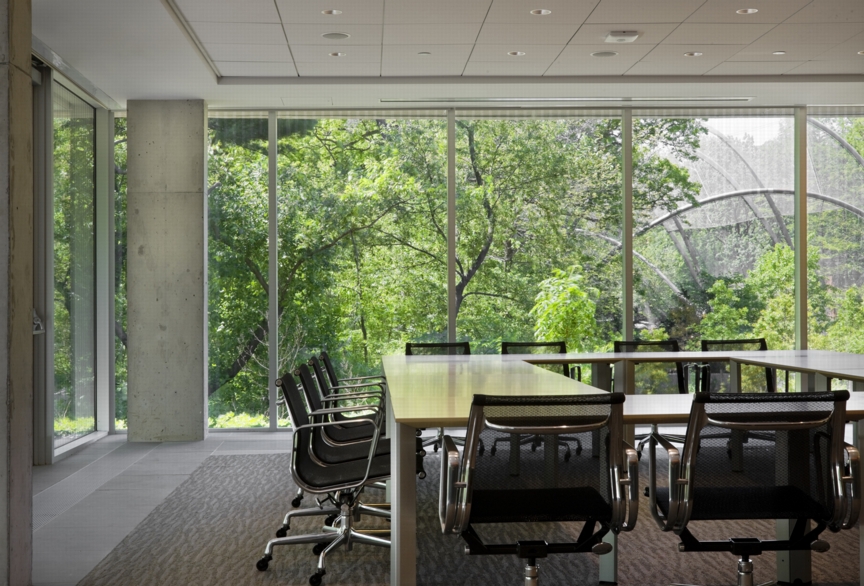This has been a concern of mine, although I live in a small Brazilian town. People are now fencing their houses with glass, and I naturally though that would be a bird trap... I had no scientific knowledge of the real problem, and, of course, no idea that there were intelligent and creative people working on it! Glad to hear about your job, about your creation. If I were a bird mom, I'd probable sing for you... Congratulations!
Blog Post
Ornilux Bird-Safe Glass

The German company Arnold Glas produces glazing with UV-reflective striping that is highly visible to birds yet nearly invisible to humans.
We've written in Environmental Building News about the tragedy of bird collisions with glazing. According to the New York City Audubon Society, 100 million birds are killed annually in the United States through collisions with buildings, primarily because the birds see reflections, rather than the glass. Daniel Klem, Jr., Ph.D., an ornithology professor at Muhlenberg College in Allentown, Pennsylvania, and the leading expert on bird collisions with buildings, considers this to be the second greatest cause of avian mortality--after habitat destruction.
Fortunately, some smart people at leading-edge companies around the world are working on this problem. Among the strategies that have been used to minimize bird collisions with buildings are gluing hawk silhouette decals to the glass, using glass imprinted with a ceramic fritting pattern, applying patterned plastic films, installing exterior shading systems that help birds see the building (as with the New York Times headquarters building in New York City), planting vegetation close to heavily glazed facades; and installing netting on the outside of large windows.

A solution that has less of a visual impact on the building (for us) relies on differences in the visual acuity of birds and humans. Ornilux glass, made in Merkendorf, Germany by Arnold Glas, has patterning of UV-reflective coating that is nearly transparent to humans but clearly visible to birds. Birds are able to see a broader spectrum of UV light than humans, according to the Arnold Glas website.
The first installation of Ornilux bird-friendly glass was in 2006 on the glass façade of a 100-year-old indoor swimming pool building in Plauen, Germany. The building uses 2,700 square feet (250 m2) of insulated Ornilux SB1 glazing. Like other types of glass, Ornilux can be fabricated into a wide range of glazing systems, including high-performance double- and triple-glazed systems with low-emissivity (low-e) coatings.
In the U.S., the New York City architecture firm FXFOWLE was the first to use Ornilux. The glazing was installed on a portion of the Center for Global Conservation at the Bronx Zoo, which was completed in 2009. (The bird-safe glass was originally specified for the entire building, but was value-engineered out for all but one corner conference room.) FXFOWLE principal Bruce Fowle, FAIA has been a leading proponent of bird-safe glazings, and his wife, Marcia Fowle, co-authored the 55-page Bird-Safe Building Guidelines, published in 2007 by the New York City Audubon Society. (A pdf file of the Guidelines can be downloaded for free.)
SUPPORT INDEPENDENT SUSTAINABILITY REPORTING
BuildingGreen relies on our premium members, not on advertisers. Help make our work possible.
See membership options »
Visually, the UV-reflective pattern on Ornilux glass is visible, but it is less apparent that many of the other strategies that have been tried to minimize bird collisions. To date, this glass has been used primarily on buildings where wildlife protection has been a high priority, such as nature centers, but as awareness of this problem grows, the use of this glazing, and competing products, may grow.
In 2009, a new version of Ornilux glass was introduced, called Mikado (German for the game of "pick-up-sticks"). Rather than even striping, Mikado glass has a random pattern of lines. To date, several installations of Ornilux Mikado glass have been completed in Germany, but none in the U.S.
Ornilux glass is distributed in the U.S. by Roeder Windows & Doors, which is advertising on its website the availability of Ornilux glass in its window and door products at no up-charge through June, 2011. The glass is also offered as an option on NanaWall operable glass wall systems.
Environmental Building News will be running a more detailed review of Ornilux glass and, possibly, other glazing systems designed to minimize bird collisions in an upcoming issue.
For more information:
Arnold Glas
www.ornilux.de (English website available)
lisa.welch@arnold-glas.de
Roeder Windows & Doors
476 E. Main Street
Ventura, California 93001
805-895-9436
See more on this product in the GreenSpec Guide
Alex Wilson is the executive editor of Environmental Building News and founder of BuildingGreen, LLC. In addition to this product-of-the week blog, he writes the weekly Energy Solutions blog. To keep up with his latest articles and musings, you can sign up for his Twitter feeds.
Published October 31, 2010 Permalink Citation
(2010, October 31). Ornilux Bird-Safe Glass. Retrieved from https://www.buildinggreen.com/news-article/ornilux-bird-safe-glass



Add new comment
To post a comment, you need to register for a BuildingGreen Basic membership (free) or login to your existing profile.